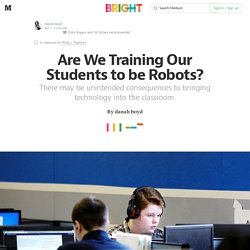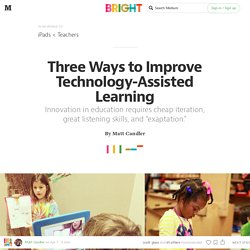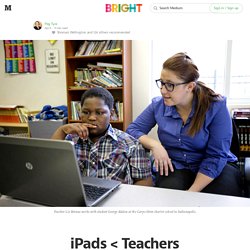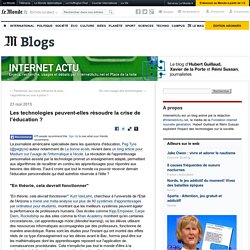

Accueil - sup-numerique.gouv.fr. Bright. Are We Training Our Students to be Robots? — Bright. There may be unintended consequences to bringing technology into the classroom.

By danah boyd Excited about the possibility that he would project his creativity onto paper, I handed my 1-year-old son a crayon. He tried to eat it. I held his hand to show him how to draw, and he broke the crayon in half. I went to open the door and when I came back, he had figured out how to scribble… all over the wooden floor. Crayons are pretty magical and versatile technologies. From crayons to compasses, we’ve learned to incorporate all sorts of different tools into our lives and educational practices.
The arguments that Peg Tyre makes in “iPads < Teachers” are dead on. But rather than seeing learning as a process and valuing educators as an important part of a healthy society, we keep looking for easy ways out of our current predicament, solutions that don’t involve respecting the hard work that goes into educating our young. Education shouldn’t be just about reading, writing, and arithmetic. Three Ways to Improve Technology-Assisted Learning — Bright. Innovation in education requires cheap iteration, great listening skills, and “exaptation.”

By Matt Candler I loved reading Peg’s piece, especially her take on effective personalized learning at Bricolage Academy — a school I’ve watched grow from an idea in Josh Densen’s head to a thriving community fulfilling many of its promises. While I agree with Peg’s frustrations about personalized and blended learning overall, her focus on myth-busting stops short of explaining how innovative schools like Bricolage actually get the way they are. Valuing teachers is important, but there’s much more to effective innovation than that. In particular, I think what makes Bricolage and other innovative communities so disruptive is a focus on mindset before resources. Here are three techniques great innovators use to create communities like Bricolage — techniques that will make your use of personalized and blended learning better tomorrow.
Good innovators start cheap and iterate. Good innovators steal. iPads < Teachers — Bright. There is no magic device that helps kids learn more.

When you hear about some grand new initiative to give every student an iPad or smartphone, be very skeptical. No single piece of technology has yet to change the basic nature of teaching and learning. Radio, television, CDs, Smartboards, and personal computers were all hailed as transformative educational innovations in their day. They were not. iPads won’t be either. There is a big difference between finding new ways to deliver information and true educational innovation, which is a far more complicated endeavor. For the most part, education software is worse than you think. Teaching may look easy, but great teaching is complicated. Master teachers are something like NBA stars; they have a seemingly endless supply of tiny, almost gestural moves that can have a big impact on a kid’s cognition. Technology-assisted personalized learning has come a long way, but it’s hard to get software to replicate what teachers do. Les technologies peuvent-elles résoudre la crise de l’éducation.
La journaliste américaine spécialisée dans les questions d'éducation, Peg Tyre (@pegtyre) auteur notamment de La bonne école, revient dans un long article pour Medium sur l'usage de l'informatique à l'école.

La révolution de l'apprentissage personnalisé assisté par la technologie promet un enseignement adapté, permettant aux algorithmes de recalibrer en continu les apprentissages pour répondre aux besoins des élèves. Faut-il croire que tout le monde va pouvoir recevoir demain l'éducation personnalisée qui était autrefois réservée à l'élite ? "En théorie, cela devrait fonctionner" "En théorie, cela devrait fonctionner". Kurt VanLehn, chercheur à l'université de l'Etat de l'Arizona a mené une méta-analyse sur plus de 80 systèmes d'apprentissages par ordinateur pour étudiants, montrant que les meilleurs systèmes peuvent égaler la performance de professeurs humains. Image : Le centre d'apprentissage Carpe Diem d'Indianapolis, via Medium. L'école comme laboratoire de R&D Hubert Guillaud.